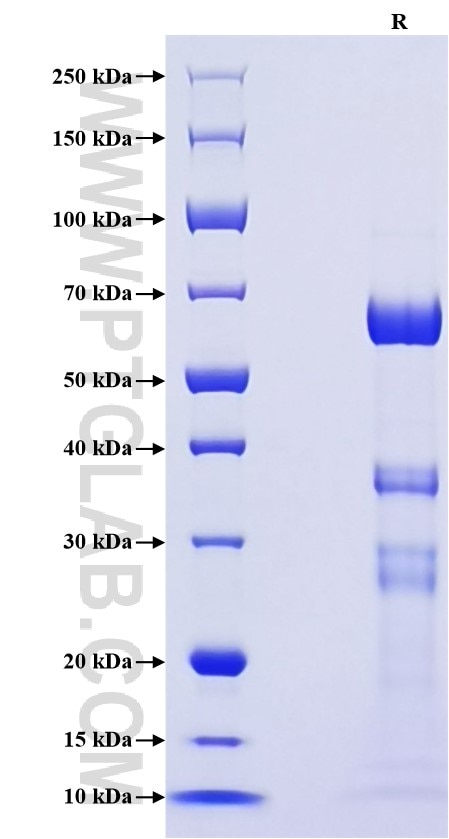Recombinant Mouse tPA protein (rFc Tag)
Species
Mouse
Purity
>90 %, SDS-PAGE
Tag
rFc Tag
Activity
not tested
Cat no : Eg3025
Validation Data Gallery
Product Information
| Purity | >90 %, SDS-PAGE |
| Endotoxin | <0.1 EU/μg protein, LAL method |
| Activity |
Not tested |
| Expression | HEK293-derived Mouse tPA protein Leu18-Gln559 (Accession# P11214) with a rabbit IgG Fc tag at the C-terminus. |
| GeneID | 18791 |
| Accession | P11214 |
| PredictedSize | 87.2 kDa |
| SDS-PAGE | 27-30 kDa, 35-37 kDa and 58-68 kDa, reducing (R) conditions |
| Formulation | Lyophilized from 0.22 μm filtered solution in PBS, pH 7.4. Normally 5% trehalose and 5% mannitol are added as protectants before lyophilization. |
| Reconstitution | Briefly centrifuge the tube before opening. Reconstitute at 0.1-0.5 mg/mL in sterile water. |
| Storage Conditions |
It is recommended that the protein be aliquoted for optimal storage. Avoid repeated freeze-thaw cycles.
|
| Shipping | The product is shipped at ambient temperature. Upon receipt, store it immediately at the recommended temperature. |
Background
tPA (Tissue-type plasminogen activator), also known as Plat, is a serine proteinase found in the intravascular space and the CNS. In the brain tPA is found in the endothelial cell–basement membrane–astrocyte interface, where it modulates cerebrovascular tone and the permeability of the blood-brain barrier. tPA is a key component in the dissolution of blood clots, primarily by catalyzing the conversion of plasminogen to plasmin, the primary enzyme involved in dissolving blood clots.
References:
1. Echeverry R, et al. (2010). J Clin Invest. Jun;120(6):2194-205. 2. Bugge, T. H., et al. (1996). Proc Natl Acad Sci U S A. Jun 11;93(12):5899-904. 3. Sashindranath M, et al. (2012). Brain. Nov;135(Pt 11):3251-64. 4. Collen D, et al. (2004). J Thromb Haemost. Apr;2(4):541-6.
